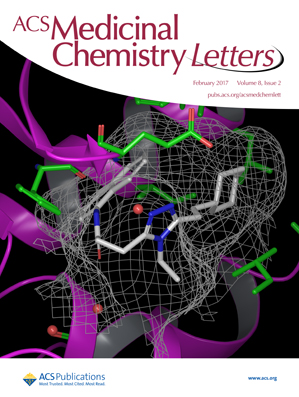基于聚焦结构的虚拟筛选识别新的SOS1抑制剂
IF 4
3区 医学
Q2 CHEMISTRY, MEDICINAL
引用次数: 0
摘要
SOS1是KRAS的关键调控因子之一,它催化KRAS激活所需的gtp到gdp的转换。抑制SOS1::KRAS相互作用是一种有吸引力的策略来调节异常的KRAS激活,这是导致几种恶性肿瘤的原因。在这项工作中,我们对阿斯利康公司收集的重原子计数在21到26之间的化合物进行了虚拟筛选,并确定了两种新的有效的SOS1结合物,它们满足已知化合物中已知的最低药理要求。随后,基于结构和知识的方法被应用于将这些结合物开发成SOS1的功能抑制剂。本文章由计算机程序翻译,如有差异,请以英文原文为准。

Focused Structure-Based Virtual Screening Identifies Novel Inhibitors of SOS1
SOS1 is one of the key regulators of KRAS where it catalyzes the GTP-to-GDP turnover required for KRAS activation. Inhibition of the SOS1::KRAS interaction is an attractive strategy to modulate abnormal KRAS activation, which is responsible for several malignancies. In this work, we performed a virtual screening campaign on the AstraZeneca compound collection with Heavy Atom Count between 21 and 26 and identified two novel and efficient binders of SOS1 which fulfill the minimal pharmacophoric requirements disclosed in known compounds. Subsequently, structure- and knowledge-based approaches were applied to develop these binders into functional inhibitors of SOS1.
求助全文
通过发布文献求助,成功后即可免费获取论文全文。
去求助
来源期刊

ACS Medicinal Chemistry Letters
CHEMISTRY, MEDICINAL-
CiteScore
7.30
自引率
2.40%
发文量
328
审稿时长
1 months
期刊介绍:
ACS Medicinal Chemistry Letters is interested in receiving manuscripts that discuss various aspects of medicinal chemistry. The journal will publish studies that pertain to a broad range of subject matter, including compound design and optimization, biological evaluation, drug delivery, imaging agents, and pharmacology of both small and large bioactive molecules. Specific areas include but are not limited to:
Identification, synthesis, and optimization of lead biologically active molecules and drugs (small molecules and biologics)
Biological characterization of new molecular entities in the context of drug discovery
Computational, cheminformatics, and structural studies for the identification or SAR analysis of bioactive molecules, ligands and their targets, etc.
Novel and improved methodologies, including radiation biochemistry, with broad application to medicinal chemistry
Discovery technologies for biologically active molecules from both synthetic and natural (plant and other) sources
Pharmacokinetic/pharmacodynamic studies that address mechanisms underlying drug disposition and response
Pharmacogenetic and pharmacogenomic studies used to enhance drug design and the translation of medicinal chemistry into the clinic
Mechanistic drug metabolism and regulation of metabolic enzyme gene expression
Chemistry patents relevant to the medicinal chemistry field.
 求助内容:
求助内容: 应助结果提醒方式:
应助结果提醒方式:


